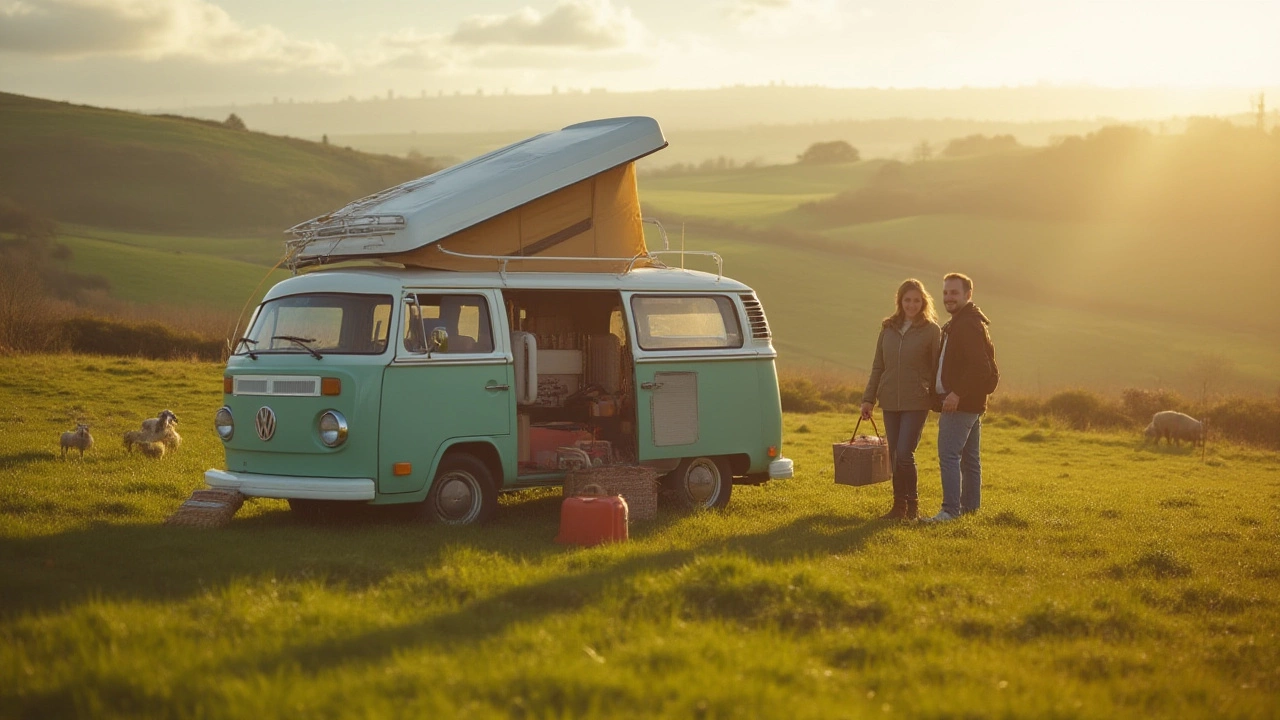Ever tried digging for the real cost of hiring a VW campervan for a week, only to get lost in vague "from €50 per day" guesses and half-answered forum threads? Back when my wife and I first plotted a weeklong escape in a classic van with our son Renly, I was convinced there would be a clear answer. Here’s the truth: prices are all over the place, and there are sneaky extras that catch out even seasoned travellers. I’ll walk you through everything I learned, from base rates to hidden fees, so you can actually plan that unforgettable road trip without getting stung by price shocks.
How Much Does It Cost to Hire a VW Campervan for a Week?
Let’s cut through the marketing fluff. On average, hiring a VW campervan in Ireland runs from €700 to €1,200 per week in the summer peak (July, August), and around €400 to €800 in the off-season. Where the price lands within that range depends on the age of the van, how many people you’re cramming in, distance limits, and where you collect and return it.
If you’re thinking of one of those newer VW California models, expect the higher side of the range. The old-school classic T2 or T3 vans—the ones that look brilliant in your Instagram photos—sometimes command a premium as well, even with their quirkier, less modern interiors. Here’s a real-world example: last July, we paid €980 for a 7-night rental out of Dublin, mid-range VW T6, sleeping three. That included insurance but not bedding or extras.
Split by season, here’s a quick comparison:
| Season | Average Weekly Price (VW T6) |
|---|---|
| June-August (peak) | €900-€1,200 |
| March-May, September-October | €600-€900 |
| November-February | €400-€700 |
Notice how prices dip hard in winter, but some companies shut up shop after October. Classic vans can be harder to find off-peak too—lots live in dry storage to prevent rust. Always check specific dates and book early for summer; the best vans get scooped up 6-12 months ahead.
So, what are you getting for the money? Most Irish rental firms include a fully serviced van, basic insurance, kitchen kit, cooking gas, and at least one full tank of fuel (or fair use policy). Mileage limits vary, but many offer up to 2,000 km per week—more than enough unless you’re circling the entire coast. You’ll need to pay a damage deposit, usually between €750 and €1,200, refundable if you bring the van back in good shape and on time.
If you want the classic pop-top, surf-rack style, those cost extra because the restoration and upkeep are so much higher. It’s not just for show, by the way—classic campers often run slower and burn more fuel, so budget a bit more for diesel or petrol during your trip.
What’s Included—and What Costs Extra?
This is where the devil hides in the details. Most people see “all-inclusive” but end up forking out more for essentials. Here’s what a standard weekly rate does and doesn’t cover, from our own rentals and reviewing dozens of providers across Ireland and the UK.
- Insurance: Standard third-party insurance is included, with a hefty excess (think €1,000+ is normal if you make a claim). Extra cover to reduce excess is always extra, usually €10-€20 per day.
- Bedding: Sheets, duvets, and pillows frequently aren’t included. Expect to pay €30-€60 per trip if you don’t bring your own.
- Bike Racks: €20-€50 if you want to bring your bicycles.
- Child Seats: Only sometimes included. Double-check, especially if you’ve got kids like Renly! Fees tend to hover around €20-€35 a week.
- Camping Tables & Chairs: Add another €25-€40 if you want somewhere to eat outside.
- Extra Driver Fees: Most policies only cover one named driver. Adding your partner can tack on €5-€10 per day.
- Cleaning: If you return the van dirty, that’s another €40-€100 gone. Some companies ask for a cleaning fee upfront.
- Pets: Bringing your dog? Some van owners allow it for a €50-€100 cleaning surcharge.
Not all companies charge for every extra. One trick is to go direct to owner-operators instead of middleman aggregate websites—prices are often friendlier, and extras may be bundled in. If you see a "too good to be true" list price, check for compulsory add-ons before booking.
VW campervan hire can really climb north of €1,500 for the week if you toss in high-season rates, insurance add-ons, extras, and maybe a campsite or two with electrical hookups. Clever packing—bring your own bedding, cook for yourself most nights—will slash the biggest incidentals.

Ways to Save Money: Real Tips That Work
If you spend half as long comparing rental deals as most people spend hunting for hotels, you’re missing discounts. Based on my own Dublin-to-Galway route planning (Google Sheets at the ready!) and chats with other camper-fanatics, these are the best ways to save real money:
- Book Early: Summer prices creep up in March and April. The good deals and best vans go way ahead.
- Travel Shoulder Season: Week in May or September? Prices and crowds are lower, weather’s still decent for outdoor adventure.
- Take Long Rentals: Per-day rates drop sharply after six days—seven-night hires often cost little more than five-night ones minus flexibility.
- Return to the Same Location: Some companies charge a "one-way fee" up to €200 if you drop off somewhere different.
- Go Old-School: The classic VW vans often come at a discount in shoulder and low season because there’s less demand. Just know they drive slower and use more fuel.
- Compare Direct vs. Marketplace Pricing: Some well-known booking sites whack 10–15% margins on top of owners’ actual rates. Always check direct.
- Bring Your Own Gear: From folding chairs to duvets, every extra item you pack yourself saves a fee.
- Limit Extras: Unless you really need two drivers or pet-friendly setups, prune the add-ons.
One sneaky but brilliant hack: ask about insurance upgrades at pickup, not at booking. Sometimes the desk staff can trim €5-€10 a day compared to online rates. I did this last summer at Cork airport and saved nearly €40 for the week on excess reduction.
Don’t forget about campsite or parking costs: most of Ireland’s council-run campsites are €25-€40 per night for two adults and one or two kids with a van, extra for electricity. Wild camping is technically not legal but widely tolerated in rural areas if you’re respectful; always ask a local and never park in sight of “No Camping” signs.
Final tip? Set yourself a petrol or diesel budget. A VW T6 or California averages 7–8 litres per 100km, but the older models can gulp double that. Even over a week, that’s a hidden €60-€120 that first-timers often forget.
The Experience: Is It Worth the Price?
Alright, spreadsheet logic aside: what does your week in a VW campervan actually feel like? Picture this. Waking up to a misty sunrise over Lough Corrib, brewing coffee with the little stove as your family rustles awake—a far cry from chain hotels. Eating fresh-caught fish, exploring wild beaches no Airbnb could ever reach, and getting rain-hammered in Galway with the heater fighting back as Renly laughs in the back. There’s a flexibility to van life that’s addictive, and it’s not just nostalgia or Instagram envy. Our own rental last summer went from “let’s just try this once” to “maybe we sell the hatchback and get one of our own?”
The price tag makes sense when you tally up the alternative. Hotels will run you €100–€200 per night for a family room in summer, and that’s before meals out, petrol, attraction tickets. A van folds travel and accommodation into one (plus a bit of DIY fun and the freedom to pivot plans). And you get your own portable basecamp—no endless packing up suitcases each morning.
Just be honest about comfort: even the plush VW Californias aren’t luxury suites. The beds can be tight, rainy nights noisy, the kitchen tiny. It’s much more fun if you treat it as a rolling adventure, not a replacement for a fancy villa. Renly loved the adventure angle (“I get to sleep on the top bunk!”) but if you’ve got teens or fussy sleepers, set expectations. The classic T2 and bay window models can be slow and draughty (which somehow made the road to Doolin all the more memorable).
On the flipside, you get memories that hotels and routine self-catering never come close to. If you catch a sunrise on Achill, or park up beside a ruined castle under the stars, you’ll see why this experience is worth splashing out for at least once. And yeah, the photos aren’t half bad either.
If you’re thinking “Should I?”—do it at least once. But research your camper, triple-check what’s included, and budget for more than just the base rate. That way, the only surprise you get is stumbling across an empty Donegal beach at sunset, not a €200 bill for a forgotten extra.
